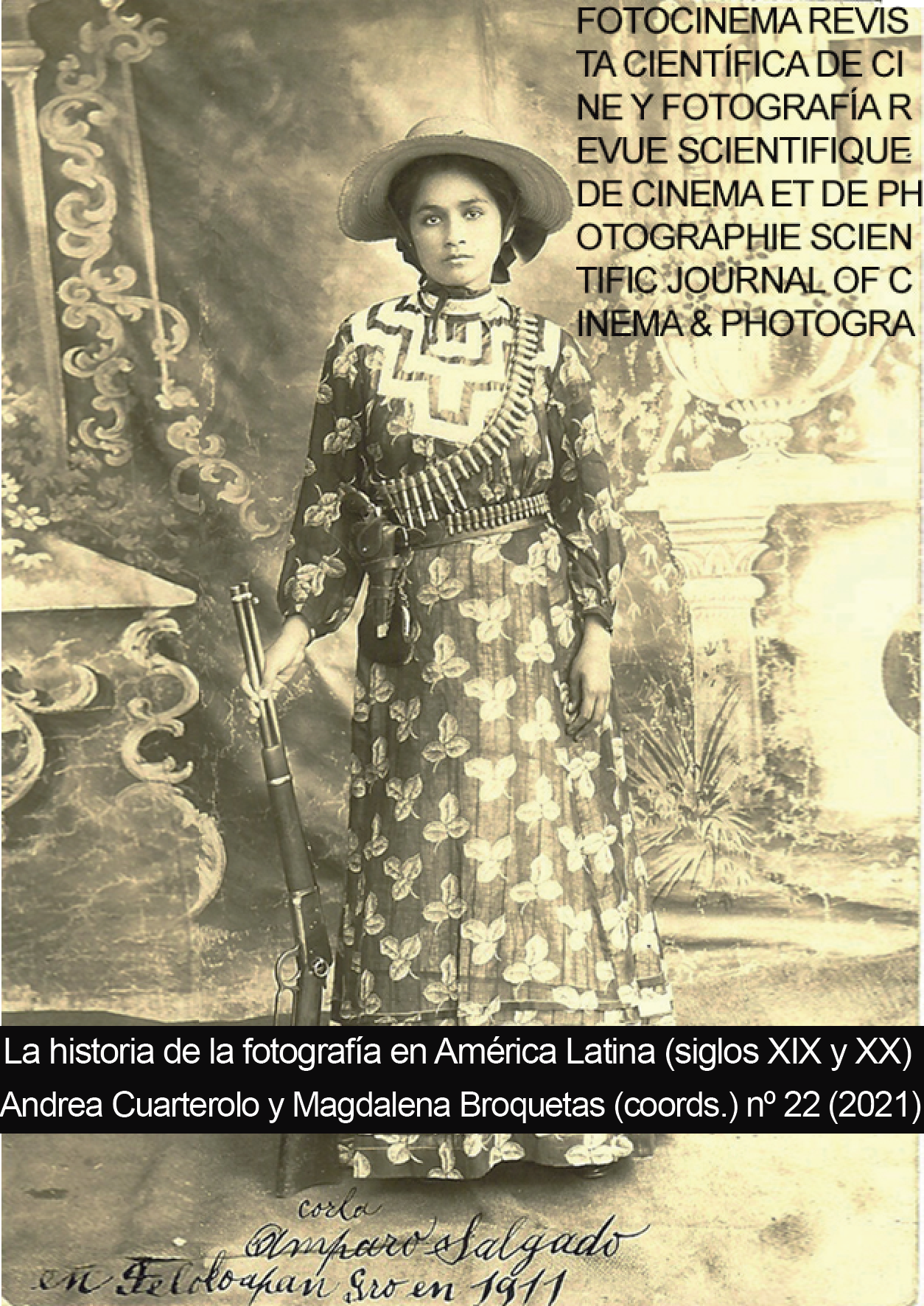The images of Faces Places (2017). A reflection from the performative documentary and the visual studies
DOI:
https://doi.org/10.24310/Fotocinema.2021.vi22.11728Keywords:
Performative documentary, Visual studies, Emotion, Visuality, ImagesAbstract
In this text, the film Faces Places by the filmmaker Agnès Varda and the graphic artist JR (2017) is analyzed, taking into account his condition as a performative documentary and following some theoretical-methodological guidelines that visual studies as a field and as a method offer. This analysis allows us to reflect on the emotional and reflexive functions of images, whether photographic, cinematographic, large format, analog or digital. As well as its aesthetic and socio-political impact following the contributions of Bill Nichols, Nicholas Mirzoeff and Gille Deleuze. The analysis is divided into four types of images that help to understand how the film works narratively and aesthetically, a documentary that is also made up of photographic installations and their replicas on the internet, these are: installation images, introspection images, absence images and images reproduction, a taxonomy under construction that can serve as a basis for the study of other films of this nature.
Downloads
Metrics
References
Brea, J. (2005). Estética, Historia del Arte, Estudios Visuales. Estudios Visuales. Ensayo, teoría y crítica de la cultura visual y el arte contemporáneo, 3, 8-25.
Bruzzi, S. (2000). New Documentary: A Critical Introduction. Londres: Routledge.
Català, J. (2005). La imagen compleja: la fenomenología de las imágenes en la era de la cultura visual. Barcelona: Universidad Autónoma de Barcelona.
Català, J. (2008). La forma de lo real. Introducción a los estudios visuales. Barcelona: UOC.
Deleuze, G. (1984). La imagen-movimiento. Barcelona: Paidós.
Deleuze, G. (2004). La imagen-tiempo. Barcelona: Paidós.
Entrevista con Nicholas Mirzoeff: Visualidad, contravisualidad e imagen digital. (26 de julio de 2013). Revista Código. Recuperado de https://revistacodigo.com/arte/entrevista-con-nicholas-mirzoeff/
Godard, J. (1964). Bande à part. Francia: Columbia Pictures.
Gómez-Peña, G. (2005). En defensa del arte del performance. Horizontes Antropológicos, 24, 199-226.
Merino, I. (2019). Agnès Varda. Espigadora de realidades y ensueños. Donostia San Sebastián: Donostia Kultura.
Mirzoeff, N. (2016). Cómo ver el mundo: Una nueva introducción a la cultura visual. Barcelona: Paidós.
Nichols, B. (1991). La representación de la realidad. Barcelona: Paidós.
Nichols, B. (1994). Blurred Boundaries: Questions of Meaning in Contemporary Culture. Indianapolis: Indiana University Press.
Nichols, B. (2001). Introduction to Documentary. Indianapolis: Indiana University Press.
Plantinga, C. (1997). Rhetoric and Representation in Nonfiction film. Cambridge: Chapbook Press.
Rice, S. (2011). El hilo de Ariadna: en las Playas que son Agnès Varda. L'Atalante. Revista De Estudios Cinematográficos, 12, 64-69.
Varda, A. (1962). Cléo de 5 à 7. Francia: Ciné Tamaris, Rome Paris Films.
Varda, A. (1976). L'une chante, l'autre pas. Francia: Ciné Tamaris.
Varda, A. (1981). Mur murs. Francia: Ciné Tamaris.
Varda, A. (1985). Sans toit ni loi. Francia: Films A2, Ciné Tamaris, Centre Méditerranéen de Création Cinématographique, Film 4, Ministère de la Culture.
Varda, A. (2000). Les glaneurs et la glaneuse. Francia: Ciné Tamaris.
Varda, A. (2008). Les Plages d'Agnès. Francia: Ciné Tamaris, France 2.
Varda, A. y Jean René (2017). Visages Villages. Francia: Ciné Tamaris, Arte France Cinéma, Social Animals.
Zumalde, I. (2011). La emoción fílmica. Un análisis comparativo de las teorías cinematográficas. Revista Latina de Comunicación Social, 66, 326-349.
Downloads
Published
How to Cite
Issue
Section
License
All contents published in Fotocinema Revista científica de cine y fotografía are protected under the Creative Commons Attribution-NonCommercial-ShareAlike 4.0 International (CC BY-NC-SA 4.0) license. All about this license is available in the following link: <http://creativecommons.org/licenses/by-nc-sa/4.0>
Users can copy, use, redistribute, share and exhibit publicly as long as:
- The original source and authorship of the material are cited (Journal, Publisher and URL of the work).
- It is not used for comercial purposes.
- The existence of the license and its especifications are mentioned.
There are two sets of authors’ rights: moral and property rights. Moral rights are perpetual prerogatives, unrenounceable, not-transferable, unalienable, imprescriptible and inembargable. According to authors’ rights legislation, Fotocinema. Revista científica de cine y fotografía recognizes and respects authors moral rights, as well as the ownership of property rights, which will be transferred to University of Malaga in open access. The property rights are referred to the benefits that are gained by the use or the dissemination of works. Fotocinema. Revista científica de cine y fotografía is published in an open access form and it is exclusively licenced by any means for doing or authorising distribution, dissemination, reproduction, , adaptation, translation or arrangement of works.
Authors are responsable for obtaining the necessary permission to use copyrighted images.














13.png)



